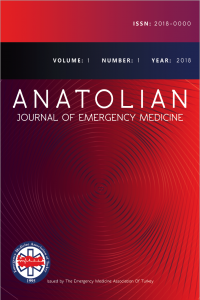Pelvik fraktürün eşlik etmediği yüksek enerjili künt travmaya bağlı ekstraperitoneal mesane rüptürü: iki olgunun bildirimi
Öz
Künt batın travması, özellikle mesane dolu iken meydana geldiyse, mesane rüptürüne yol açabilir. Mesane rüptürü hastalarının %70 ila %97’sinde eşlik eden bir pelvik kırık da olduğu gösterilmiş olup tanıda altın standart retrograd sistogramdır. Bu olgu serisinde, üretral kontrast ile yapılan retrograd BT sistografi ile tanısı konulan iki farklı ekstraperitoneal tip IV mesane rüptürü olgunu bildiriyoruz. Literatürün aksine, her iki vakada da yüksek enerjili künt travmaya ragmen pelvik kırık belirlenmemiştir. Her iki vakada da epidural ve subdural kanamalar görülmesi bu hastaların maruz kaldığı yüksek enerjili travmayı kanıtlamaktadır. Her iki vaka da basit kateterizasyon ve drenaj ile tedavi edilmiştir. Mesane rüptürü pelvik kırık olmaksızın da görülebildiğinden künt batın travmasında retrograd BT sistografinin vazgeçilmez bir tanısal test olduğu görüşündeyiz. Meada kan olmaması ya da pelvik kırık görülmemesinin mesane rüptürü olmadığının birer göstergesi kabul edilemeyeceği inancındayız.
Kaynakça
- Cass AS. Diagnostic studies in bladder rupture. Indications and techniques. Urol Clin North Am. 1989 May;16(2):267-73.
- Rehm CG, Mure AJ, O'Malley KF, et al. Blunt traumatic bladder rupture: the role of retrograde cystogram. Ann Emerg Med. 1991 Aug; 20(8):845-7.
- Carroll PR, McAninch JW. Major bladder trauma: mechanisms of injury and a unified method of diagnosis and repair. J Urol. 1984 Aug; 132(2):254-7
- Lynch TH, Martínez-Piñeiro L, Plas E, et al. EAU guidelines on urological trauma. Eur Urol. 2005 Jan;47(1):1-15
- Corriere JN Jr, Sandler CM. Bladder rupture from external trauma: diagnosis and management. World J Urol. 1999 Apr;17(2):84-9.
- Carroll PR, McAninch JW. Major bladder trauma: Mechanisms of injury and a unified method of diagnosis and repair. J Urol. 1984 Aug;132(2):254-7.
- Cass AS: The multiple injured patient with bladder trauma. J Trauma. 1984 Aug;24(8):731-4.
- Peng MY, Parisky YR, Cornwell EE 3rd, et al. CT cystography versus conventional cystography in evaluation of bladder injury. AJR Am J Roentgenol. 1999 Nov;173(5):1269-72.
- Quagliano PV, Delair SM, Malhotra AK. Diagnosis of blunt bladder injury: A prospective comparative study of computed tomography cystography and conventional retrograde cystography. J Trauma. 2006 Aug;61(2):410-21; discussion 421-2.
- Gomez RG, Ceballos L, Coburn M, et al. Consensus statement on bladder injuries. BJU Int. 2004;94:27–32.
Extraperitoneal bladder rupture without pelvic fracture due to high-impact blunt trauma: the report of two cases
Öz
Blunt trauma of the abdomen may cause rupture of the bladder especially when the bladder is distended. It is shown that 70–97% of patients with bladder rupture from trauma have associated pelvic fractures, and retrograde cystogram is the gold standard for the diagnosis.In this report, we present two cases of extraperitoneal Type IV bladder rupture diagnosed with retrograde CT cystography with urethral contrast. Contrary to the literature, in both cases, nopelvic fractures were present despite high-energy impactions. Epidural and subdural hematomas in both cases certify the high-energy of the impact these patients exposed. Both cases were managed with simple catheterization and drainage.We think that retrograde CT cystography is an indispensable diagnostic tool for blunt pelvic trauma patients since bladder injuries may occur without pelvic fractures. Absence of meatal blood or pelvic fractures may not necessarily rule-out the presence of bladder injuries.
Kaynakça
- Cass AS. Diagnostic studies in bladder rupture. Indications and techniques. Urol Clin North Am. 1989 May;16(2):267-73.
- Rehm CG, Mure AJ, O'Malley KF, et al. Blunt traumatic bladder rupture: the role of retrograde cystogram. Ann Emerg Med. 1991 Aug; 20(8):845-7.
- Carroll PR, McAninch JW. Major bladder trauma: mechanisms of injury and a unified method of diagnosis and repair. J Urol. 1984 Aug; 132(2):254-7
- Lynch TH, Martínez-Piñeiro L, Plas E, et al. EAU guidelines on urological trauma. Eur Urol. 2005 Jan;47(1):1-15
- Corriere JN Jr, Sandler CM. Bladder rupture from external trauma: diagnosis and management. World J Urol. 1999 Apr;17(2):84-9.
- Carroll PR, McAninch JW. Major bladder trauma: Mechanisms of injury and a unified method of diagnosis and repair. J Urol. 1984 Aug;132(2):254-7.
- Cass AS: The multiple injured patient with bladder trauma. J Trauma. 1984 Aug;24(8):731-4.
- Peng MY, Parisky YR, Cornwell EE 3rd, et al. CT cystography versus conventional cystography in evaluation of bladder injury. AJR Am J Roentgenol. 1999 Nov;173(5):1269-72.
- Quagliano PV, Delair SM, Malhotra AK. Diagnosis of blunt bladder injury: A prospective comparative study of computed tomography cystography and conventional retrograde cystography. J Trauma. 2006 Aug;61(2):410-21; discussion 421-2.
- Gomez RG, Ceballos L, Coburn M, et al. Consensus statement on bladder injuries. BJU Int. 2004;94:27–32.
Ayrıntılar
| Birincil Dil | İngilizce |
|---|---|
| Bölüm | Vaka Takdimi |
| Yazarlar | |
| Yayımlanma Tarihi | 21 Eylül 2018 |
| Yayımlandığı Sayı | Yıl 2018 Cilt: 1 Sayı: 1 |


